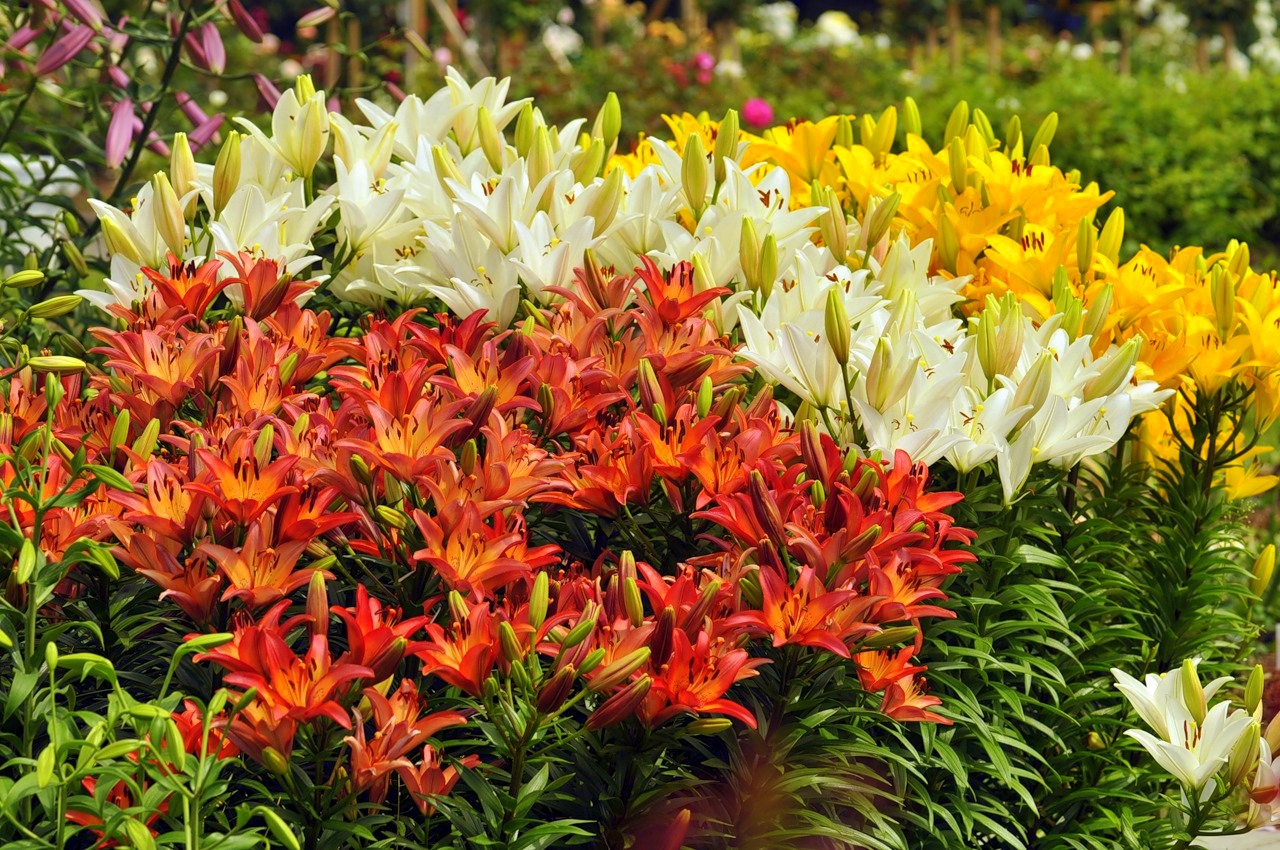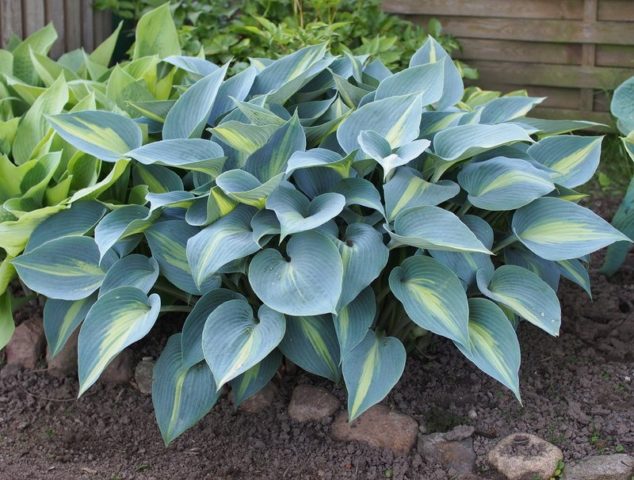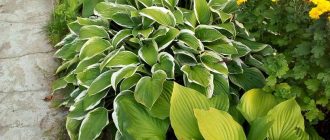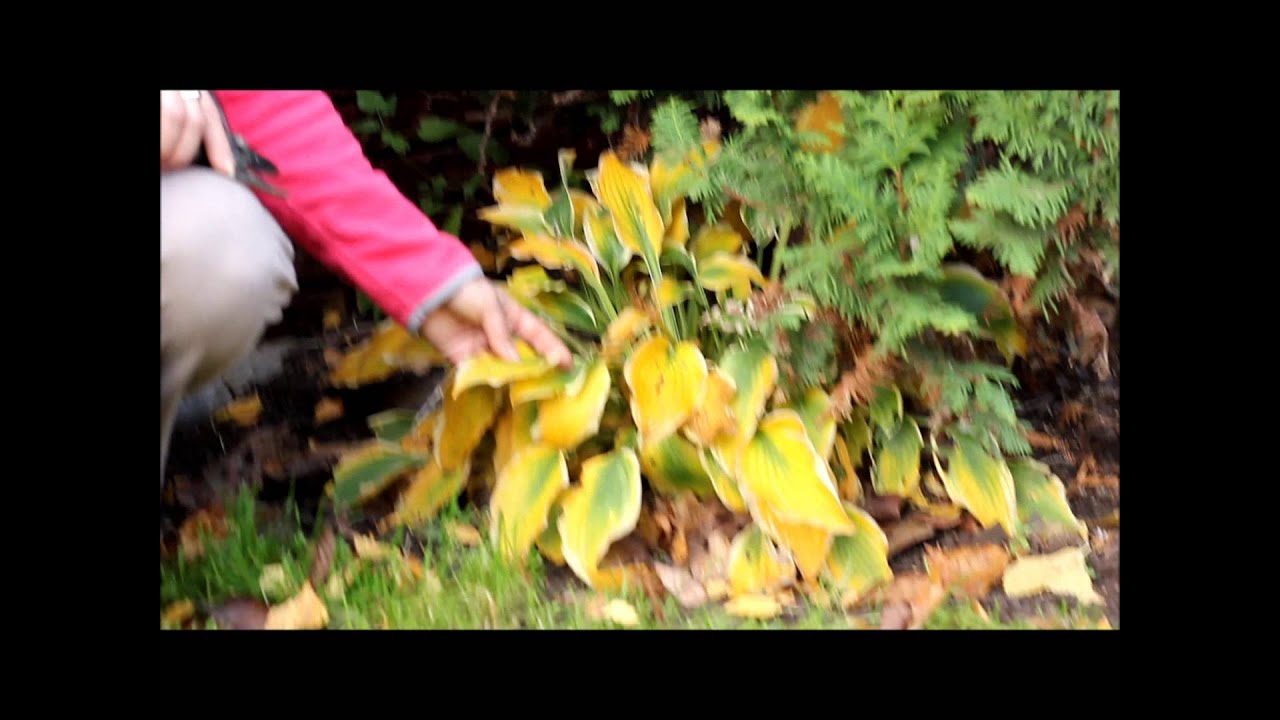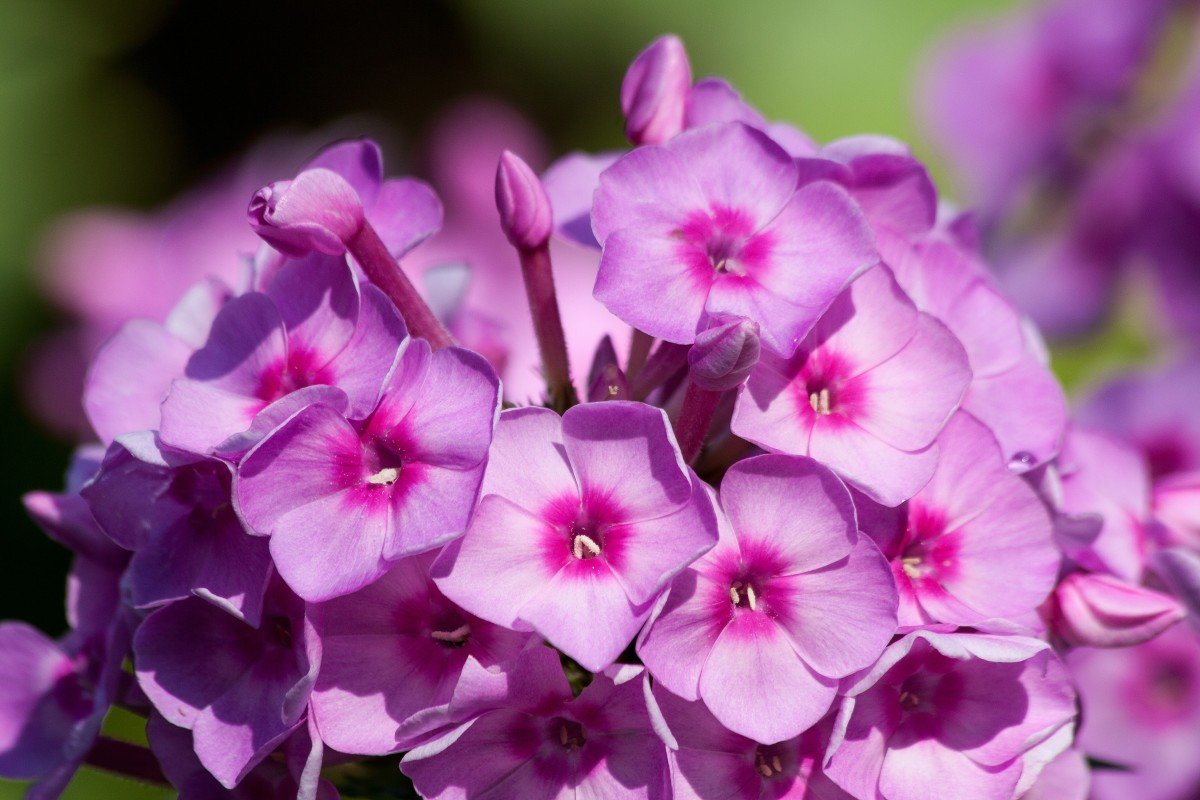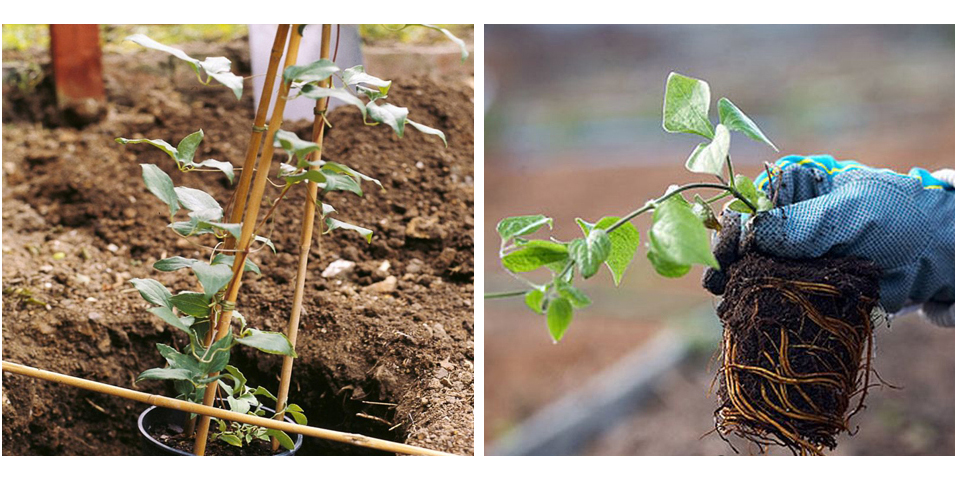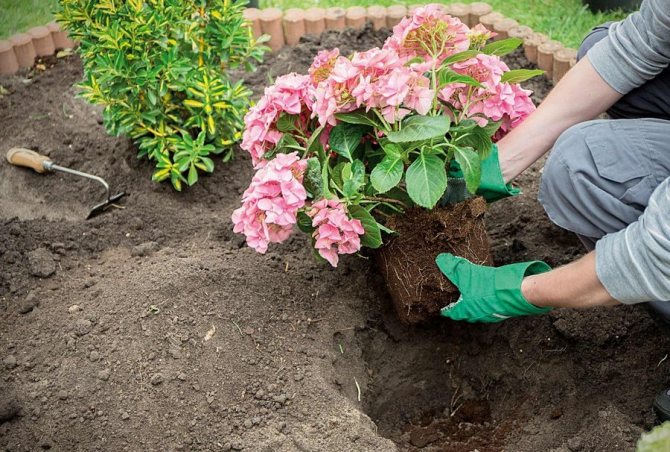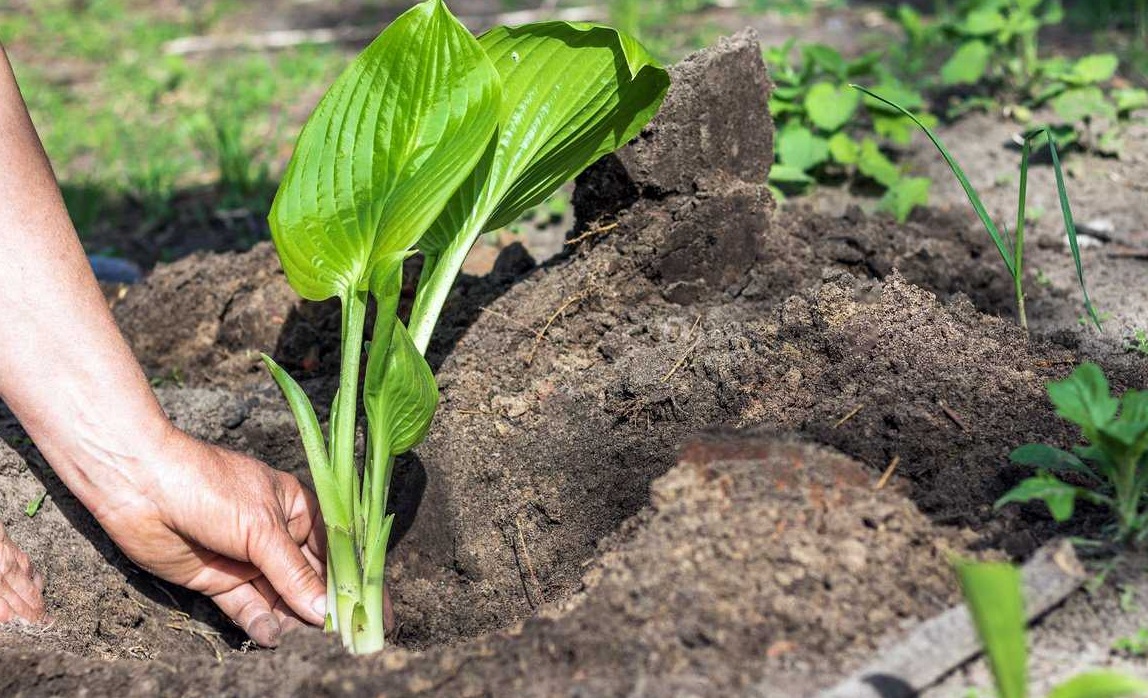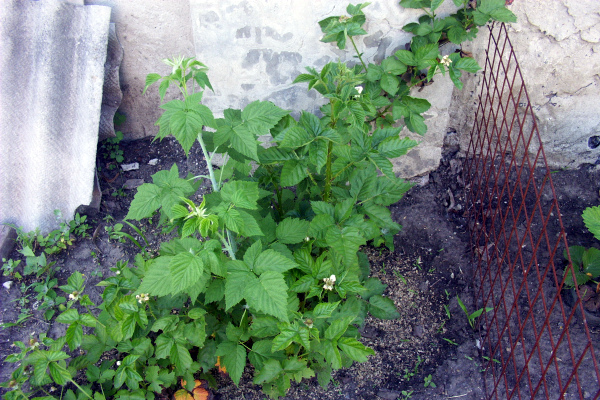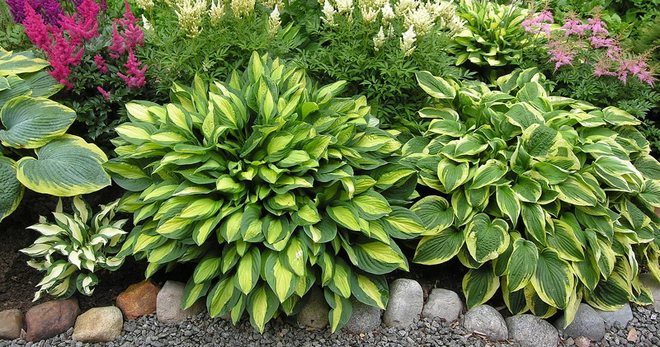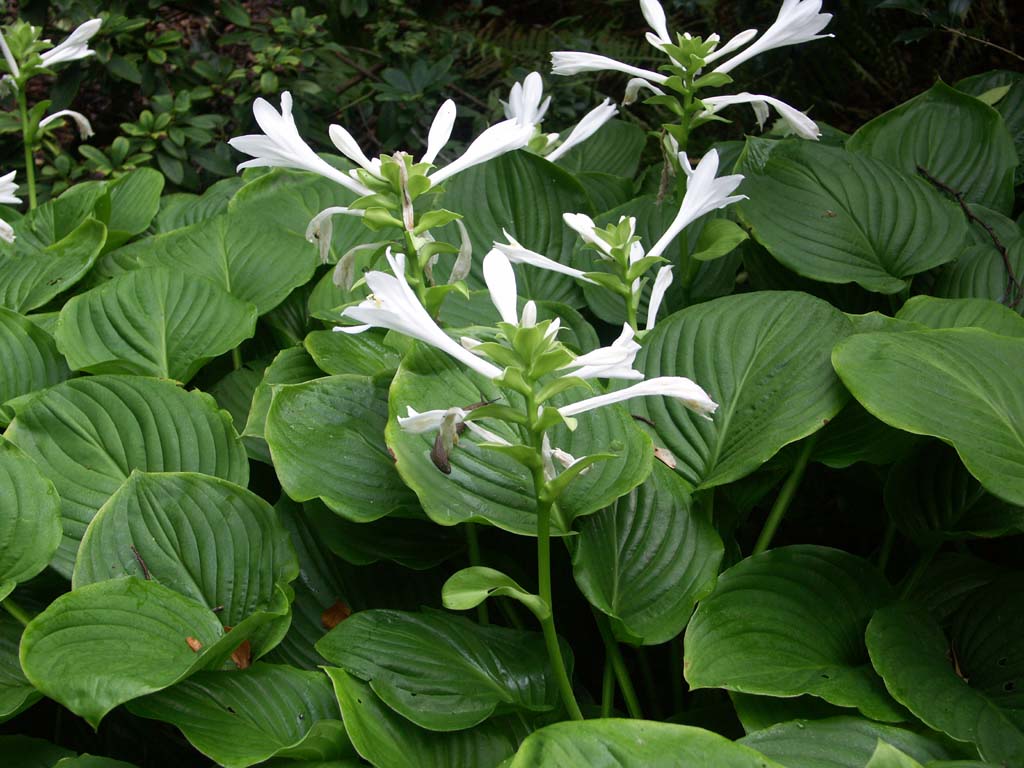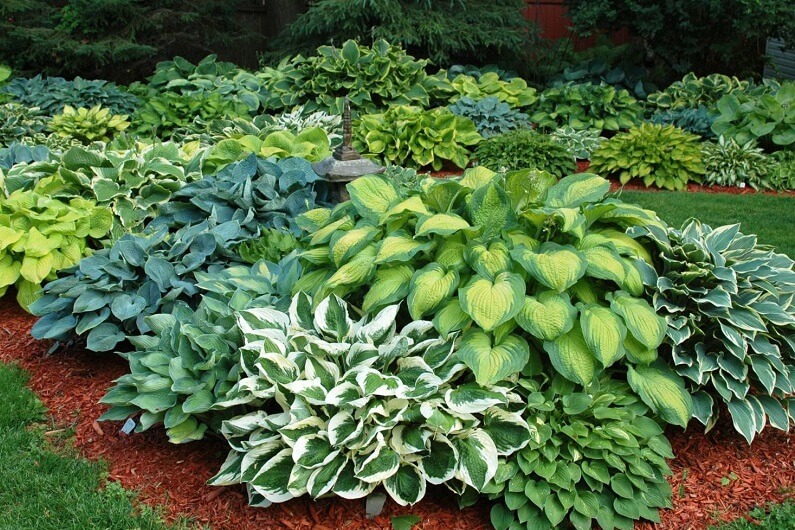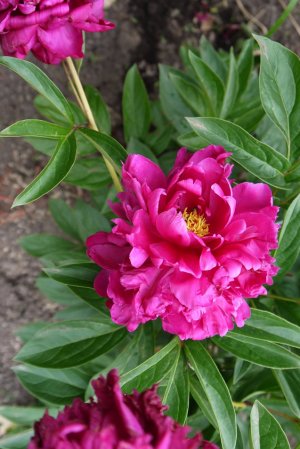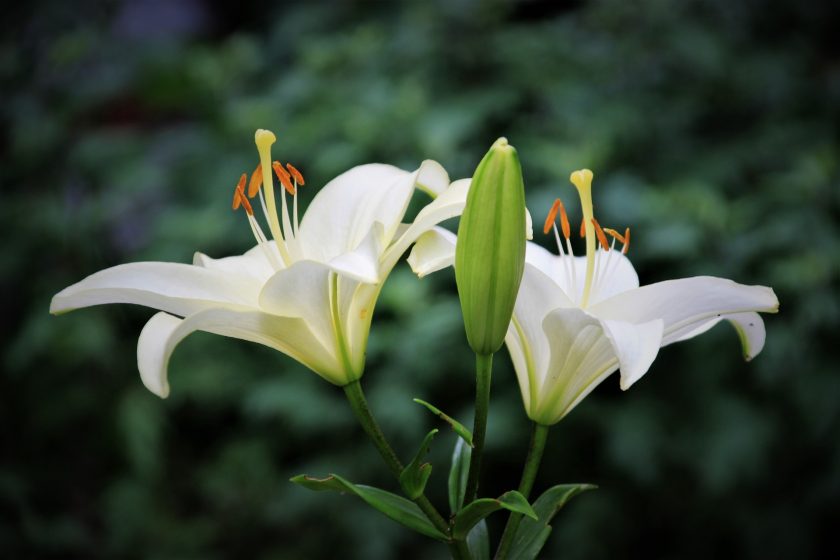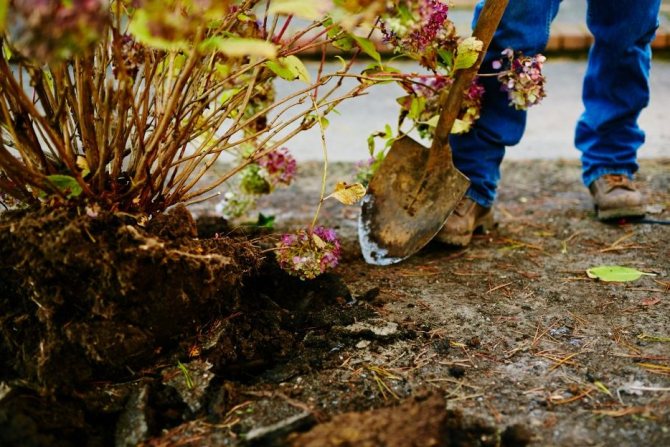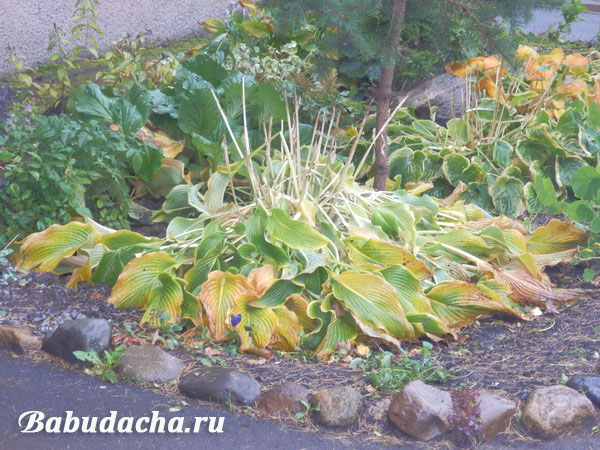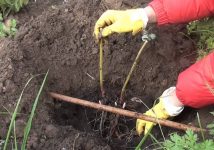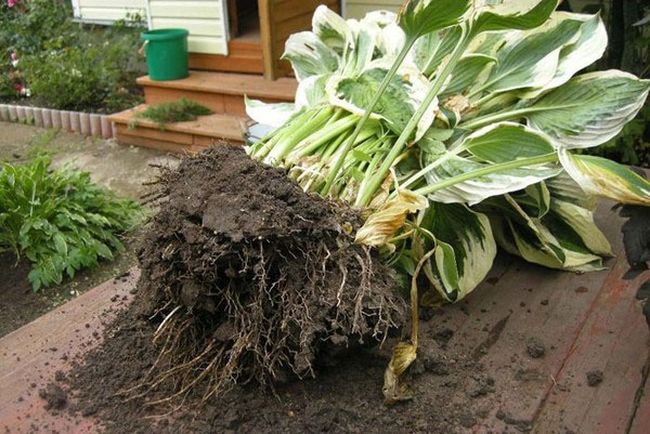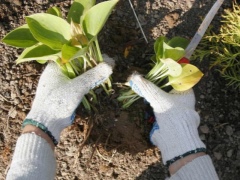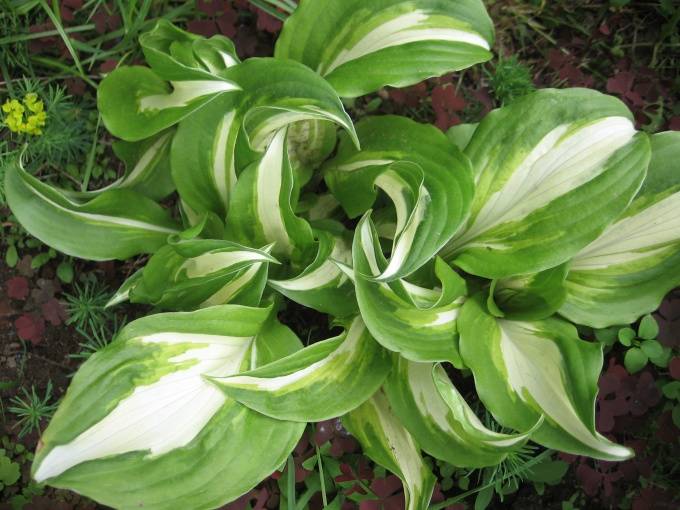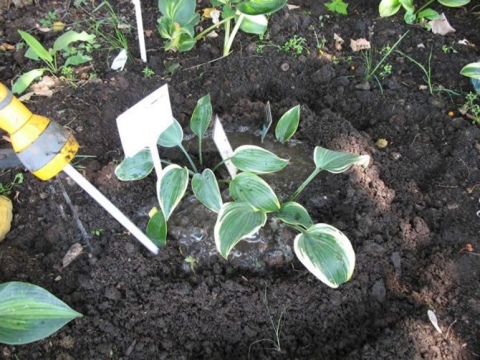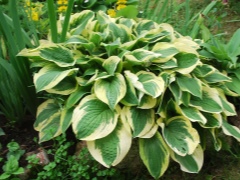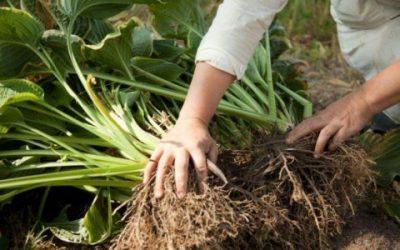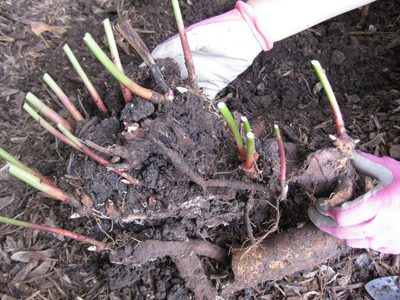Pests and diseases hosts
The plant does not get sick so often. In addition, pests do not "love" him too much, but you need to be ready in any case.
The most common host problems are:
1. Fusarium. A fungal disease that damages the leaves. Symptoms - the appearance of spots of red-brown color, which very quickly capture the surface of healthy leaves.
If signs of fusarium are found, it is necessary to immediately cut out all the leaves damaged by the disease and treat the plant with colloidal sulfur or Vectra.
2. Gray rot. The disease starts from the tips of the leaves. They rot. Then the disease spreads to the entire surface of the leaf plate. All affected leaves must be destroyed immediately. In this case, the host should be treated with Topaz or Bordeaux liquid.
3. Decay of the root collar. The disease is the result of over-watering. Diseased plants need to be dug up, the affected areas must be cut out. After that, the host needs to be placed in a solution of potassium permanganate and transferred to a new place.
Among the pests, slugs and nematodes can be distinguished. Slugs feed on plant leaves, gnawing small holes in them. Nematodes also harm the decorativeness of the flower, gnawing passages in the leaves. To save the plant, it is best to transplant the host.
In landscape design, deciduous ornamental plants are popular, which bring harmony and completeness to garden compositions. Among them, a special place is occupied by such perennials as hosts, or funkias, in which magical leafy colors are combined with sophistication and elegance. The varieties of this plant are called the queens of the shadows.
Blue and green, gray and golden leaves on lush bushes with stripes and contrasting edges along the edges - gardeners will immediately say that this is a hosta.
A transplant in the fall makes it possible to perfectly beat such qualities of this plant as unpretentiousness, and most importantly, their ability to maintain their exotic yellowish-golden colors until the first frost.
That is why the hosta, a representative with rather large and dense leaves, is very popular.
Agro-specialists believe that the hosta transplant in autumn or spring should be done only if necessary, since the plant is quite difficult to tolerate this process. After the procedure, it comes to its senses for a long time, losing its external splendor for some time.
However, experienced gardeners who grow this ornamental crop on their site know how it can grow, interfering with the normal existence of other flowers in the flower beds. That is why the hosts are transplanted in the fall. Before proceeding to change the habitat of the bush, you need to carefully consider a new site for its growth, since it is not recommended to subject the plant to such a test several times.
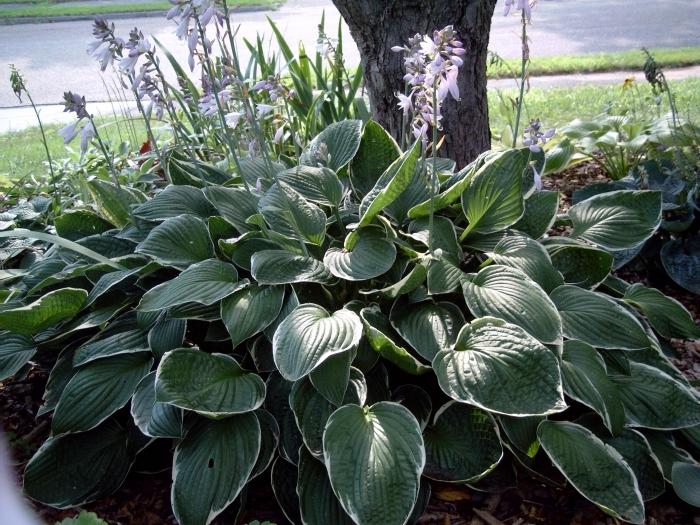 Many believe that spring is the best time for transplanting hosts, since it is during this season that young shoots appear from the ground. You can do this throughout the summer.
Many believe that spring is the best time for transplanting hosts, since it is during this season that young shoots appear from the ground. You can do this throughout the summer.
Some breeders are sure that replanting hosts in autumn is the right decision. True, there are certain time limits for this: it is desirable that this be carried out no later than the end of September. This is explained by the fact that for the rooting and adaptation of the bush before the onset of the first cold weather, it takes some time - at least one month.
At the same time, the most common varieties of this ornamental plant - "Siebold" and "Tokudama" with their hybrids - have one distinctive feature.Their roots do not grow at all in the spring.
Transplanting hosts in the fall begins with a complete digging of the bush. After that, the roots are shaken off the ground. Their ends are slightly trimmed to rejuvenate the plant. The rhizomes are cut with a knife, and then broken by hands. Experienced gardeners recommend that the fracture sites be treated with a fungicide solution or ash.
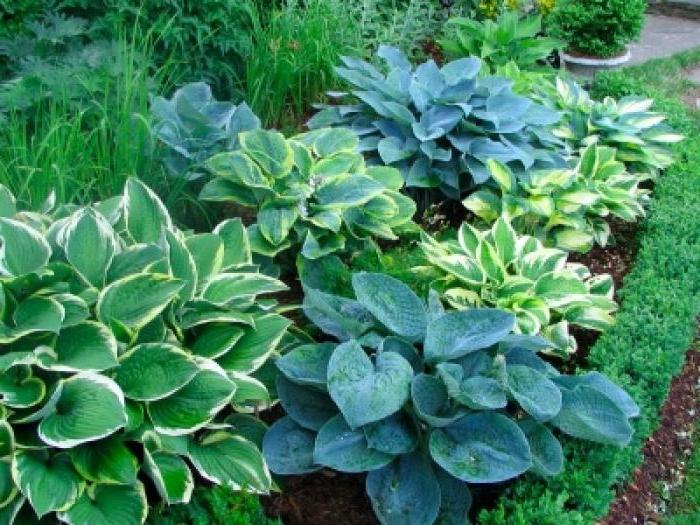 The plant prefers light, fertile soils with medium acidity. A few hours before the hosta is transplanted in the fall, the area where it should be planted is abundantly watered. If necessary, the hole is covered with peat or fallen leaves.
The plant prefers light, fertile soils with medium acidity. A few hours before the hosta is transplanted in the fall, the area where it should be planted is abundantly watered. If necessary, the hole is covered with peat or fallen leaves.
If several bushes are transplanted at once, it must be borne in mind that the size of an adult plant is quite impressive. Therefore, you need to plant at a distance of at least one meter from each other.
The root collar, which should be at ground level, must be mulched with humus.
Transfer in the fall: for!
Now let's analyze what conditions are created during autumn and spring planting. And when is it better to replant trees - in spring or autumn?
Soil moisture in autumn
Soil moisture in the fall is maintained by itself. After an autumn transplant, the soil is optimally moist for the next 3-4 months without additional watering. The exception is the southern regions, where autumn can be dry. In other regions, after the autumn rains, the best conditions for transplanting are created.
As for spring plantings, they require constant watering. At the same time, with the onset of summer heat, the soil periodically dries up, and this slows down the growth of new root hairs. In addition, the beginning of the growing season requires active work of the roots and the absorption of water, followed by its evaporation from the surface of the leaves.
The roots of a newly transplanted tree are unable to provide the seedling with the necessary amount of moisture. The transplanted tree develops very slowly and dries up partially.

Autumn soil temperature
When planting seedlings in autumn, the soil retains the heat accumulated over the summer. When it is already +5 outside, the temperature of the soil at the depth of the roots is about + 10 ° C. At the same time, there is an additional bonus - the growing season has already stopped, there is no sap flow, the roots "work" without load.
Thus, ideal conditions are created for the restoration of the root system. Cool at the top, warm enough at the bottom near the roots. And also - wet, we talked about this in the previous section.
In winter, only the upper layers of the soil freeze. With the correct transplantation of seedlings to a sufficient depth, when their root system is in the frost-free zone, slow root growth can last all winter.
The exception here will be the northern regions, in which the soil freezes deep enough. In such areas, young seedlings may freeze completely after the autumn planting. And only those trees will survive in winter, the root system of which stretches deeply and reaches the frost-free line.
For them, winter has become a time of growth and preparation for spring. Therefore, transplanting fruit trees in the fall creates conditions for their fruiting as early as the next season. Spring seedlings will need to build up the root system during the summer.
As for planting in spring, the soil after winter warms up more slowly than air. The root system grows worse.

When and how to seat and share the host
One of the reasons why the host is seated is the overgrowth of the root system. She not only begins to occupy a large space, but the decorative qualities of the plant also decrease. The second reason may be the reproduction of the plant, the creation of new landscape compositions.
Important! You cannot seat and share the host in 1-2 years after planting. For successful growth, the rhizome must be strong enough
Young transplants need some time to adapt, only then their rapid growth begins.
Typically, the plant reaches its peak of development in the fifth or sixth year. This means that in 5 years the time comes when it is already possible to seat the host.
Before transplanting to a host, you should take a responsible approach to choosing the best place for it. These plants love shady or only partially lit areas. They are ideal for creating lush canopy under trees.
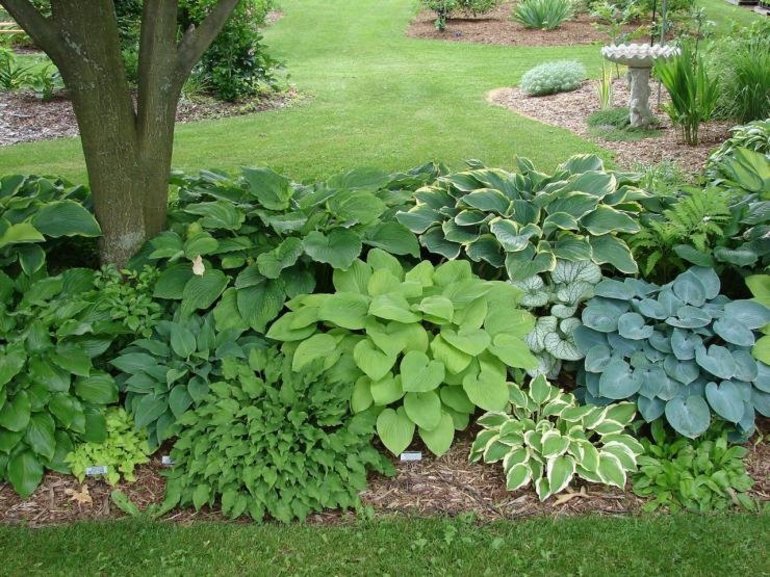
Hosta under the tree
Straight light is best tolerated by varieties with light green foliage, but it is preferable to expose them only to the morning sun. Full shade is almost never an obstacle to vegetative growth, although it can sometimes lead to loss of flowering.
Hosta is not particularly demanding on soil, but prefers a substrate rich in organic matter. Loamy soil is good for her, capable of retaining moisture, but without stagnant water. Low places prone to flooding are not suitable for planting.
Important! If the soil is too heavy, it is recommended to add river sand to it, when it is very loose, then peat. Step-by-step actions for transplanting:
Step-by-step actions for transplanting:
An adult hosta bush is dug to a medium depth, trying to get under the root ball without damaging the roots;
The plant is carefully pulled out. If a simple transplant is made, then the earth from the roots is only slightly shaken off
If necessary, divide and plant the bush, the roots are cleaned of soil by washing in water to expose them;
A new hole is prepared based on the size of the earthen coma. When dividing - about 0.4x0.4 m and 0.5 m deep. If several plants are planted, the holes should not be placed close to each other. Hosts need space for the growth of the root system, taking into account the rare transplantation, it should be sufficient: at least 0.5 m for large-leaved plants, 0.3 m - for miniature varieties;
Drainage material (small pebbles, brick chips, etc.) and a layer of sheet compost or peat are placed at the bottom of the hole;
The roots are carefully examined, damaged and dried ones are removed. For disinfection, immerse in a weak solution of potassium permanganate for 10-15 minutes;
Then it is dried in the open air (at least 1.5 hours), after which the rhizome is divided into sections with a sharp knife, sprinkling the cuts with wood ash. Each divided section should have well-developed roots and at least 2-3 leafy shoots or buds;
Individual plants are placed in the center of the hole, covered with soil, slightly compacted. At the same time, the root collar remains on the surface.
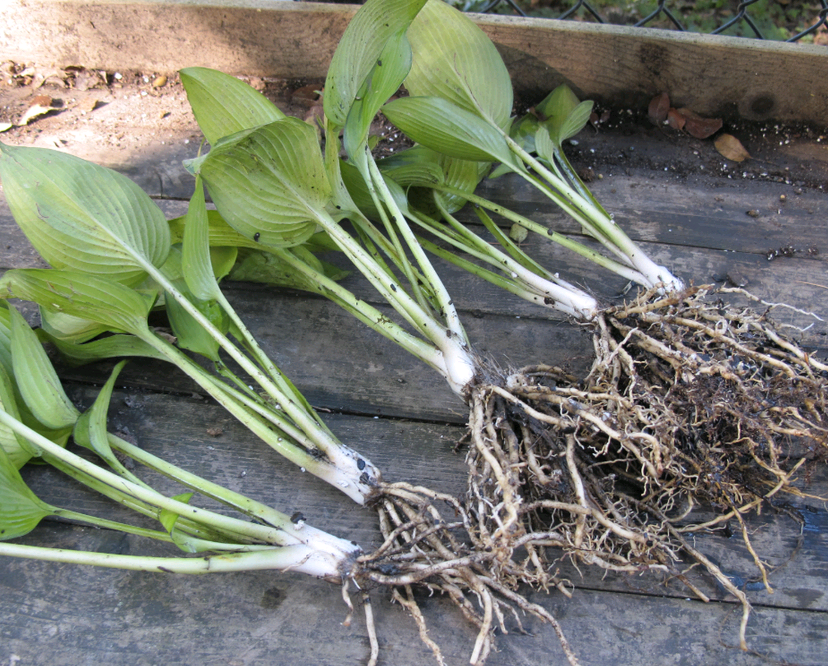
Division of hosts
Important! Freshly planted plants are watered every day over a two-week period. With an autumn transplant, you need to take care of the insulation of young plants.
They are covered with dry foliage or branches of fir trees, on the eve of the onset of cold weather, the leaves can be cut off, leaving only up to 15 cm of the stem
With an autumn transplant, you need to take care of the insulation of young plants. They are covered with dry foliage or branches of fir trees, on the eve of the onset of cold weather, the leaves can be cut off, leaving only up to 15 cm of the stem.

Transplanted host
Care after the procedure

When pruning hosts, it is better to wait for the leaves to turn yellow.
Caring for a transplanted host consists of 4 stages:
- Watering. The shrub loves generous watering with settled warm water. Early morning is ideal for this procedure. It is necessary to water the hosta at the very root, trying not to get on the leaves. Their high humidity attracts pests.
- Top dressing. The best option is mullein infusion. Feeding is carried out 3 times a year: at the very beginning of spring, during the budding period and after flowering.
- Pruning. There are some controversial opinions as to whether a host should be pruned for the winter. Opponents of such a procedure claim that since the leaves of this plant are very soft, by the spring they will most likely not be left behind.At the same time, the nutrients obtained after their decomposition will fertilize the soil well. Those who advise pruning the hosta before wintering insist that pathogens and pests may remain on the leaves.
- Mulching. Even before the air temperature drops below 0, the host needs to be mulched. Natural materials such as hay, sawdust, spruce branches and others are best suited for this. Ideal terms for mulching: no earlier than October 1 in Siberia, the Far East and the Urals, October 15 in Central Russia and October 25 in the southern part of the country.
Both before and after the transplant, it is very important to make sure that the host does not get sick. Some of the most common problems are: Some of the most common problems are:
Some of the most common problems are:
- decay of the root collar. If the bush is planted too deep, its roots may begin to rot. This problem is common in regions with very rainy autumn. When a disease is detected, the plants are carefully dug up, all damaged areas are removed and the shrub is lowered into a solution of potassium permanganate;
- slugs. These creatures feed on hosta greenery, leaving very unattractive holes. For salvation, spraying with an ash solution or dusting with ash is used;
- fusarium. It manifests itself as unpleasant brown spots that grow over the entire surface of the plant. If this problem is detected, the affected leaves are cut off and the plant is treated with Vectra.
Video: Step-by-step instructions for transplanting hosts in the fall
If you follow all the rules and recommendations, caring for the host will not cause difficulties even for the most inexperienced gardeners. And in the spring, the plant will delight with its incredible foliage, becoming the best decoration of any garden.
How to plant the host in the summer?
It is permissible to plant the hosta in the summer, in August, after the flowering of the bush. But at the same time, the transplant rules should be followed so that it does not negatively affect the healthy state of the culture.
Single shoots are not used, since it will take a very long time to wait for growth. Better to take shoots with 2-3 buds
The foliage is completely removed - this prevents intensive evaporation of water and contributes to the maximum development of the rhizome. Before the procedure, abundant watering of the roots of the mother bush is required. All sections during separation should be made with a sharp disinfected instrument, then they are coated with brilliant green and antifungal agents
After transplanting, it is very important to create shade for the planted seedlings and keep the soil moist at all times. Division is carried out on a cloudy day or in the evening so that the scorching rays do not leave burns on the cuts
Diseases and pests hosts
Perennial is rarely sick, but you still need to know about the most common diseases of hosts.
Fusarium
Khosta is susceptible to fungal diseases that spoil the appearance of the leaves. You can determine the lesion by the red-brown spots that appear on the surface of a healthy leaf. With the development of the disease, the lesion spreads to the entire surface of the leaf plate. At the first signs of a fungal disease, remove all damaged leaves and treat the shrub with Vectra.
Decay of the root collar
In the case of an incorrect autumn planting of the hosts, when the root collar is too deep in the soil, its rotting occurs. This is especially true when the weather is humid and it often rains. Compliance with all the rules for planting hosts will help prevent disease. If a disease occurs, the bush must be dug out and all damaged areas removed, and then disinfected in a solution of potassium permanganate. Next, the plant is transplanted to a new location.
Slugs
Among pests, slugs "love" the host. They feed on its leaves by making holes in them. Spraying and dusting with ash will help to save the plant.Alternatively, you can transplant the shrub to another location.
Comments
Winter, especially in the conditions of the Russian climate, is always a definite test for plants. However, if you take into account a few simple rules for preparing hosts for the winter, you can avoid losing almost one hundred percent.
Features and purpose of pruning hosts in the fall
Any hosta varieties, regardless of their size, must be pruned for the winter. Although this point of view is quite contradictory (many gardeners believe that if the bush is not cut off, the plant will prepare for winter on its own), according to the experience of many summer residents, pruning is necessary. It allows you to solve several problems:
removing yellowed leaves and dead shoots is always a useful procedure that allows you to direct all water and nutrients only to healthy parts of the plant;
pruning can significantly reduce the likelihood of damage to the green part by slugs and other pests;
the removal of flowering stems is a very important condition: if this is not done, the hosta will begin to spend energy on the formation of seeds, which significantly weakens the plant.
Autumn feeding hosts
As for the peculiarities of fertilizing the host in the autumn, here the point of view of gardeners coincides. Starting from mid-August, it is impossible to fertilize the bushes with any additional fertilizing - the plants are preparing for the winter period, biological hibernation, when activity is reduced to a minimum. The only possible option is mulching with organic fertilizing, however this fertilizer can be applied not earlier than:
- October 15 for Central Russia (Moscow region, Volga region);
- October 25 for the southern part;
- October 1 for the Urals, Siberia and the Far East.
On the need and rules for sheltering hosts for the winter
Shelter hosts for the winter - This is a mandatory and at the same time uncomplicated event. Its essence boils down to mulching and directly building a shelter. The technology is as follows:
First of all, it is important to carry out all work only on a dry day when the soil is sufficiently dry.
First, the lower layer of the bush is lightly sprinkled with earth, raking the soil from all sides.
Mix for mulch (peat, rotted sawdust, brushwood and old grass in equal proportions) is poured out next to the root collar (under the leaves).
Next, tobacco dust is poured onto the bush itself, and also sprayed with any insecticide, for example, phytosporin.
The bush is covered with any material intended for this purpose (for example, lutrasil or spnbond).
Then heavy bricks or stones are placed around the perimeter.
Common mistakes during autumn transplantation
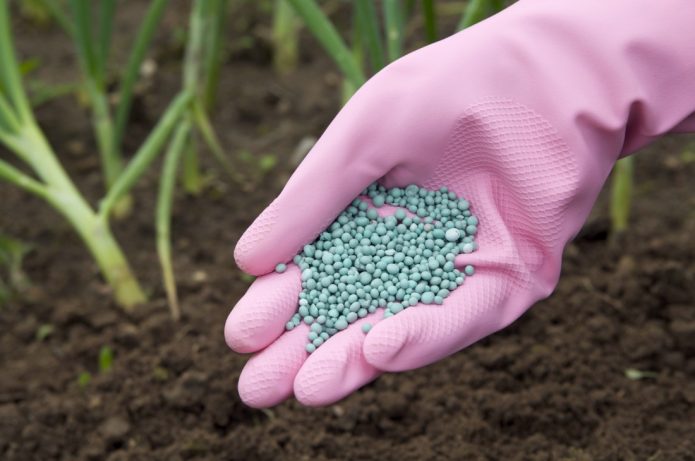
You need to be very responsible about the process, because mistakes can negatively affect the plant.
Gardeners without experience often make the following mistakes:
- fertilizing the planting pit. The nutrient medium activates growth, and the plant must begin preparing for winter;
- the use of roofing material and polyethylene. These materials contribute to the decay of hosts. To cover it, it is worth using spruce branches or branches;
- transplanting weak plants. Experienced gardeners are sure that weakened hosts should be replanted exclusively in the spring. Otherwise, there is a high risk of losing a flower.
6 Watering Tips
Inexperienced summer residents often irrigate transplanted bushes incorrectly. In the wild, hostas grow in areas with permanently moist soil, so proper watering is very important for successful cultivation. Both adult plants and young bushes must be watered under the bush, avoiding surface watering. For full saturation with moisture, 10-25 liters of water are consumed per plant, depending on the size of the bush. In this case, the soil is impregnated to a depth of 50 cm, sufficient for the normal development of the root system in deep soil layers.
In the case of surface irrigation, the roots do not receive a sufficient amount of moisture and begin to develop in the upper layer, which during periods of drought can lead to the development of diseases and loss of decorativeness of the plant.
The optimal time for watering hosts is the first half of the day, preferably before 11 o'clock (before the onset of the midday heat), when you can not be afraid of burns on the leaves. During the day, hosts can be watered only in cloudy weather, and if you water the plant in the evening, then stagnant moisture can attract snails and slugs - the main pests of the plant.


